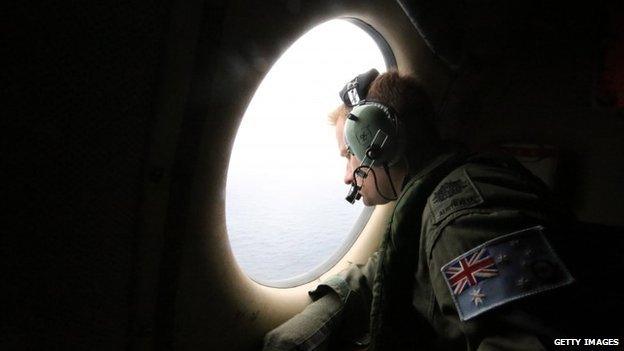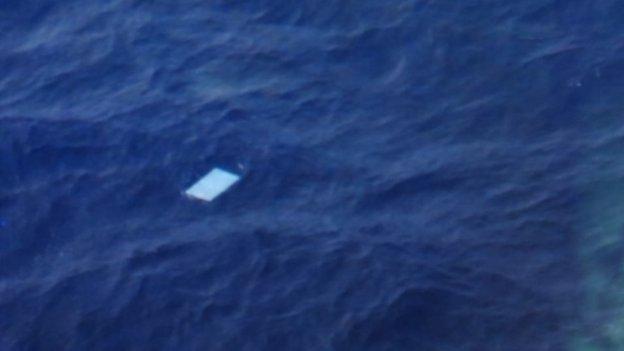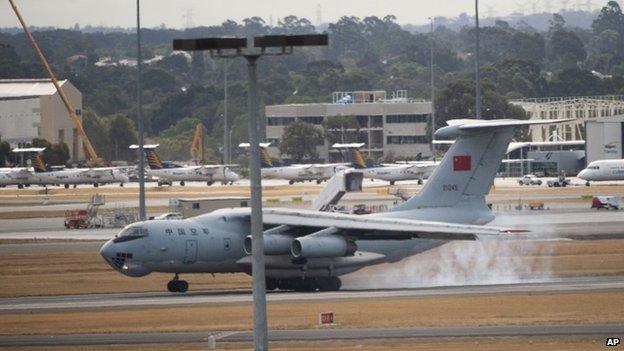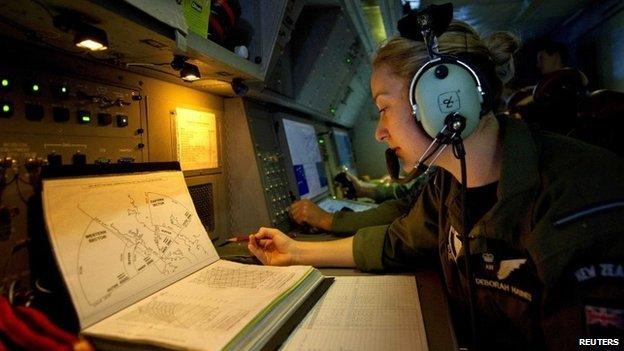Flight MH370: Aircraft debris - or a load of rubbish?
- Published

The satellites have turned up many leads - but the signal has been lost in the noise.
A white speck on a black background. Zooming in, the spectral outline of something that was perhaps part of an aircraft.
It may be a vital clue in the riddle of flight MH370, fodder for the investigators and closure of a kind for the families of the missing passengers.
Or it may be a wayward shipping container, the remnants of a fishing boat, regurgitated flotsam from the tsunami that struck Indonesia 10 years ago, driftwood, plastic waste - or just a transient fleck of foam on a boisterous sea.
None of these possibilities can be discounted in the satellite images from the southern Indian Ocean where the search for the missing Malaysian Airlines jet has been focused.
In the absence of finer data, floating debris from the plane remains critical to solving the puzzle of its disappearance.
The location and condition of any retrieved wreckage can be keyed into a complex computer model of the ocean's winds and currents. Scientists can then rewind the model to 8 March, the day the plane vanished.
If the simulation suggests that the fragments have a common origin, the search for the flight's "black box" recorders can be centred around that point.
But what is the likelihood that the white specks in the satellite photos are indeed traces of the lost aircraft?
'False positives'
Scientists have told the BBC News website that it is virtually impossible to conclude anything from the images alone.
For them, the hunt for the plane has only emphasised how little we know of the waters that cover two-thirds of the planet's surface - a knowledge as shallow as the oceans are deep.
The Indian Ocean is a frontier where theory runs into chaos.

Aircraft and ships have struggled to spot what the satellites have shown
"This is more evidence of how non-existent our marine-debris observing system is," says Nikolai Maximenko, an oceanographer at the University of Hawaii.
He pored over satellite images after the 2011 tsunami in Japan - but struggled to spot anything significant there.
"I knew that there must be thousands of objects, yet the only object that I was able to identify was a tanker, having nothing to do with the debris," he says.
"In some cases, you feel that there is something anomalous in the image but have no tools to prove it."
Floating detritus
Problems with the latest search include the time lag between the retrieval of satellite data and the arrival of ships or aircraft in the zone.
Factor in the turbulence, and an aerial photograph may be as good a guide to location as the snapshot of a coin in the spin cycle of a washing machine.
Searching for clues in the satellite images is sure to turn up "a lot of false positives", says Simon Boxall, an oceanographer from the University of Southampton.
The seas are awash in floating waste, and the Indian Ocean is no exception. But it is also a body of water about which relatively little is known.
The US and European institutions that do most of the world's oceanographic research - tracking waste, studying marine life and mapping the seabed - have focused more on the closer waters of the Atlantic and Pacific.

A coin spinning in a washing machine?
Kara Lavender Law, an expert in marine debris with the US-based Sea Education Association, says most of the information on waste sightings does not come from the Indian Ocean.
"Of all the data that I can find, out of 10,000 points on that map, I see maybe five points west of Australia," she says.
Moreover, the broad zone where the plane may have vanished is in the blackest of holes - even by the standards of the Indian Ocean.
Thousands of kilometres west of Australia, it is a part of the world that has rarely troubled corporations or governments.
The type of satellites that can scan the number plate of a car in Yemen - used by the US military and by firms such as Google - would not have been trained on these waters.
In fact, says Mr Boxall, it is unlikely that any satellites would have been capturing the kind of images that we are now seeing from that area.
That means it is very difficult to compare the recent pictures, purporting to show debris, with similar pictures before the plane went down. Those white specks may be fresh - or they may have already been there.

Wreckage from the plane could offer some kind of closure for the passengers' relatives
Scientists disagree over whether the aerial images are significant to the search. However, they also stress the need to keep an open mind until the blots seen from above have been spotted by ship.
The satellite photos cover a zone where the Indian Ocean meets the Southern Ocean, encircling Antarctica.
There is a risk, says Mr Boxall, that waste in this area could have come from any of the world's major oceans - all of which border Antarctica.
In that case, the flecks in the pictures may just be the floating detritus of globalisation, such as some of the thousands of shipping containers thought to be lost at sea every year.
'Giant pinball machine'
Other experts are more optimistic that the satellite images show aircraft wreckage.
For a start, most of the world's seaborne waste is generated in the northern hemisphere. Currents make sure most of it stays there, says Marcus Eriksen, a marine scientist who has mapped ocean debris for the US-based Five Gyres Institute.

The international rescue operation: Testing theory against chaos
Moreover, he says, large bits of "macro-debris" - such as plastic buckets - are typically found closer to the coasts of densely populated areas.
Meanwhile, the waste items that swirl around in the middle of the oceans - in sub-tropical whirlpools known as gyres - are often no bigger than a bottle-cap.
The search for the plane is centred in the southern hemisphere, thousands of miles from land. This could make it likelier that the large white specks spotted so far are connected to the missing aircraft.
The waters in the area are among the cleanest in the world, according to Erik van Sebille, an oceanographer who has tracked currents for the University of New South Wales in Australia.
Most of the water from the Southern Ocean gets "flushed northwards" towards the Equator. In theory, he says, this reduces - though does not eliminate - the possibility that floating objects in the search zone could be seaborne garbage from Asia.

The mystery of the missing plane has united scientists, militaries and governments
However, even if aircraft fragments are discovered in the area, the likelihood that they will lead to the "black box" recorders diminishes with every passing day.
The computer models can at best hope to pinpoint where the jet went down within a 50km (30 miles) radius, says Mr Sebille. But that margin of error multiplies with the turbulence of the sea and the passage of time.
"It's a giant pinball machine down there," he says, referring to the ocean's effect on floating debris.
"If you hit the ball at a slightly different angle, at a slightly different moment, [its] trajectory is going to be completely different."